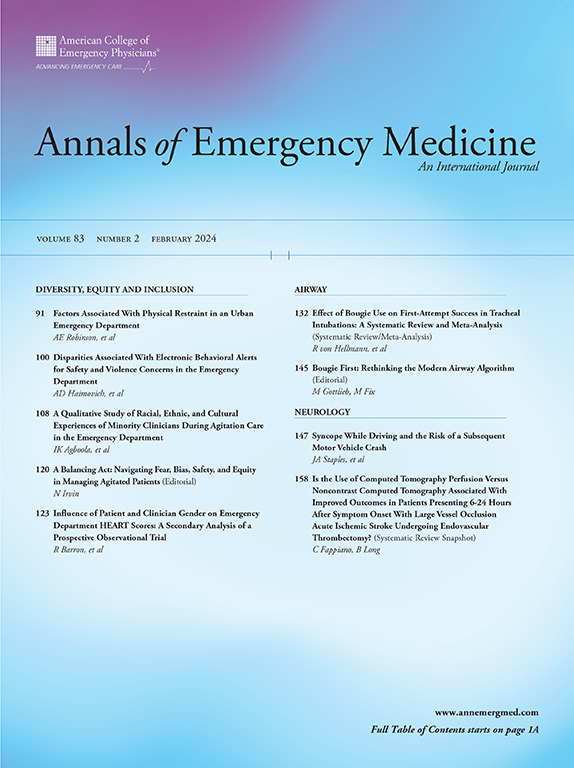Efficacy of Adding Intravenous Saline Solution to Nonsteroidal Anti-Inflammatory Drug-Based Treatment of Acute Migraine in the Emergency Department.
IF 5
1区 医学
Q1 EMERGENCY MEDICINE
引用次数: 0
Abstract
STUDY OBJECTIVE Intravenous fluid administration is frequently used alongside nonsteroidal anti-inflammatory drugs (NSAIDs) in the treatment of acute migraine in emergency departments (EDs), despite a lack of clear evidence supporting its benefit. The objective of this study was to evaluate whether the addition of 1,000 mL intravenous normal saline solution to standard NSAID-based treatment improves clinical outcomes in adults presenting to the ED with acute migraine. METHODS It was a double-blind, parallel-group, randomized controlled trial in single tertiary care academic ED (June 2020 to June 2021). Adults aged ≥18 years with migraine per International Classification of Headache Disorders, 3rd edition criteria, presenting with an acute attack. Patients with dehydration, recent intravenous fluid use, or contraindications were excluded. Of 955 screened patients, 128 were randomized; 125 were analyzed. All patients received 75 mg intramuscular diclofenac. The intervention group received 1,000 mL intravenous saline solution over 1 hour; the control group received 10 mL intravenous saline solution over 1 hour. The primary outcome was change in headache severity (100-mm visual analog scale [VAS]) at 2 hours. Secondary outcomes included rescue medication use, ED length of stay, adverse events, and functional disability. RESULTS Median VAS reduction was 62.0 mm (IQR 37.5-82.0) in the intervention group vs 48.0 mm (26.0-74.0) in controls; the Hodges-Lehmann estimated between-group difference was 10.0 mm (95% CI -2.0 to 20.0). We found no between-group differences in nausea VAS or functional disability across time points. Rescue medication use was lower in the intervention group (23.8%) than in controls (42.5%) (absolute difference 18.6%, 95% CI 2.1% to 35.0%). Median ED length of stay was shorter in the intervention group (150 vs 168 minutes; difference 19 minutes, 95% CI 0 to 39). No serious adverse events occurred; 24-hour survey outcomes were similar between groups. CONCLUSION Adding 1,000 mL intravenous saline solution to NSAID-based therapy did not produce a clear improvement in pain relief at 2 hours. Lower rescue medication use and shorter ED length of stay in the intervention group are secondary findings that may be influenced by unblinded administering staff and should be interpreted cautiously. Routine intravenous fluids should be considered selectively, particularly for patients with clinical signs of dehydration.非甾体类抗炎药治疗急性偏头痛急诊科加注静脉生理盐水的疗效观察
研究目的静脉输液经常与非甾体抗炎药(NSAIDs)一起用于急诊科(ed)治疗急性偏头痛,尽管缺乏明确的证据支持其益处。本研究的目的是评估在标准的以非甾体抗炎药为基础的治疗中加入1000ml静脉生理盐水溶液是否能改善急性偏头痛成人ED患者的临床结果。方法:该研究是一项双盲、平行组、随机对照试验,于2020年6月至2021年6月在单一三级医疗学术ED中进行。根据国际头痛疾病分类第3版标准,年龄≥18岁的偏头痛成人,表现为急性发作。排除有脱水、近期静脉输液或禁忌症的患者。在955名筛选的患者中,128名随机;分析125例。所有患者均接受75 mg肌注双氯芬酸。干预组患者1小时内静脉注射生理盐水1000 mL;对照组给予生理盐水10 mL静脉注射,持续1小时。主要结局是2小时时头痛严重程度的变化(100毫米视觉模拟量表[VAS])。次要结局包括抢救用药、急诊科住院时间、不良事件和功能残疾。结果干预组VAS中位缩小62.0 mm (IQR 37.5-82.0),对照组48.0 mm (26.0-74.0);Hodges-Lehmann估计组间差异为10.0 mm (95% CI -2.0 ~ 20.0)。我们发现各组间在恶心、VAS或功能障碍方面没有差异。干预组抢救用药率(23.8%)低于对照组(42.5%)(绝对差异18.6%,95% CI 2.1% ~ 35.0%)。干预组ED住院时间中位数较短(150分钟vs 168分钟;差异19分钟,95% CI 0 ~ 39)。未发生严重不良事件;24小时的调查结果各组之间相似。结论在以非甾体抗炎药为基础的治疗中加入1000 mL静脉生理盐水溶液,2小时后疼痛缓解效果不明显。干预组较低的抢救用药和较短的ED住院时间是次要发现,可能受到非盲管理人员的影响,应谨慎解释。应选择性地考虑常规静脉输液,特别是对有脱水临床症状的患者。
本文章由计算机程序翻译,如有差异,请以英文原文为准。
求助全文
约1分钟内获得全文
求助全文
来源期刊

Annals of emergency medicine
医学-急救医学
CiteScore
8.30
自引率
4.80%
发文量
819
审稿时长
20 days
期刊介绍:
Annals of Emergency Medicine, the official journal of the American College of Emergency Physicians, is an international, peer-reviewed journal dedicated to improving the quality of care by publishing the highest quality science for emergency medicine and related medical specialties. Annals publishes original research, clinical reports, opinion, and educational information related to the practice, teaching, and research of emergency medicine. In addition to general emergency medicine topics, Annals regularly publishes articles on out-of-hospital emergency medical services, pediatric emergency medicine, injury and disease prevention, health policy and ethics, disaster management, toxicology, and related topics.
 求助内容:
求助内容: 应助结果提醒方式:
应助结果提醒方式:


